Public Policy
Representative Bonamici Celebrations 2018 National Apprenticeship Week
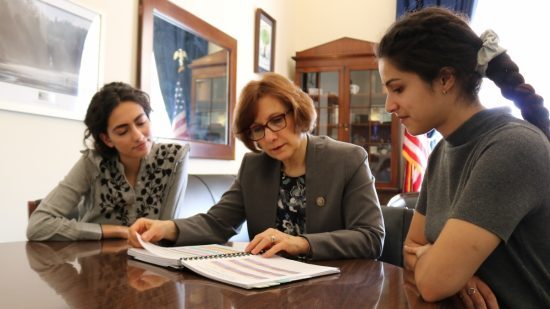
On Thursday, November 15, Women in Apprenticeship Day, Congresswoman Suzanne Bonamici (D-OR), Vice Ranking Member of the House Education and the Workforce Committee, celebrated National Apprenticeship Week and Women in Apprenticeship Day by advocating for more investments in apprenticeships and work-based learning programs.
“Efforts to get our economy back on track have benefited some, but far too many working families are still struggling to make ends meet,” Congresswoman Suzanne Bonamici said on the House floor. “As we recognize National Apprenticeship Week and Women in Apprenticeship Day, we must commit to strengthening apprenticeships and work-based learning programs.
“The PARTNERS Act and funding for the Workforce Innovation Opportunity Act are two pieces of the greater need to invest in apprenticeships and other paid, on-the-job training programs. Investing in these programs will help more people access better paying, stable careers, and provide our nation’s businesses with a workforce that will improve productivity and efficiency.”
Watch the full video of Bonamici’s floor speech.
Bonamici is a champion in Congress for apprenticeships and work-based learning programs. The first bill signing Bonamici attended was for the Workforce Innovation and Opportunity Act (WIOA) when it passed Congress in 2014. Additionally, she has been a leader in efforts to increase funding for the Workforce Innovation and Opportunity Act and Women in Apprenticeship and Nontraditional Occupations grants.
In 2017, she introduced the bipartisan PARTNERS Act to boost apprenticeships and work-based learning programs. The PARTNERS Act would establish a grant program to support the creation and expansion of industry partnerships to help small and medium sized businesses develop work-based learning programs and provide support services for workers.
Oregon Tradeswomen extends our deepest gratitude to Congresswoman Bonamici for her support of apprenticeship, and calling for stronger investments in paid, on-the-job training programs to allow more people to attain living-wage careers with benefits, and providing a pipeline of skilled workers to industries strongly in need of building their workforce.
Portland Metro Region Construction Workforce Market Study

Oregon Tradeswomen works to increase the number of women and people of color entering the skilled trades, but there are still significant barriers that make recruitment and retention of a challenge. A Workforce Market Study was jointly commissioned in January 2017 by The City of Portland and Metro, (Oregon regional governance and the only one in the nation), with the support of Oregon Tradeswomen, the National Association of Minority Contractors of Oregon (NAMCO), Oregon Employment Department (OED), Portland State University (PSU), and Worksystems Inc. to learn more about how to invest in equitable growth through diversifying our workforce.
Why should we care about diversifying our workforce? The new report states, “Diversifying the construction workforce will not only help create a stronger supply of needed workers for the industry, it will also directly address issues of poverty and economic mobility within communities of color and working families in the region.” The construction industry is also in the midst of a labor shortage. Ideally, we can prepare women and minorities to be those ideal candidates to help fill the labor gap. It isn’t as easy as it seems, though, as the study identifies barriers that make recruitment and retention of these demographics a challenge.
The study outlined 9 main barriers that hinder recruitment and retention of women and minorities in the trades. Many trades jobs come from personal referral, say from a father or friend who is already in the industry. The study shows that women and minorities have less of these gateway experiences. This goes hand in hand with the fact that there are not many communities or social networks within the industry for women and people of color which minimizes the exposure someone from those communities might have to the trades. It was also found that marginalized communities face more hardships than others due to financial issues, child care, transportation, among other things that can stand in the way of them continuing their careers.
Although Oregon Tradeswomen does great work preparing women to join the construction workforce and gives them support throughout their careers, however, there are limits to our capacity to train students, primarily due to structural limitations as to when we can conduct training and offer hands-on experiences to build skills. More than 1,100 women seek our pre-apprenticeship training each year. The problem isn’t that women aren’t interested in a career in construction, but rather, we have a limited number of slots in each cohort. This is a common barrier among pre-apprenticeship and job-readiness programs.
Some of the other barriers that keep women and people of color from continuing a career in the trades are the outdated policies that shape noninclusive jobsite cultures where women and people of color experience sexist and racist attitudes. These policies can foster hostile work environments, poor-quality training for new workers (which then makes it harder for those workers to excel and advance), and fewer opportunities for promotion for women and people of color.
As a way to address the disparity in our region, the study outlined three goals:
- Increase recruitment of diverse workers
- Increase retention of diverse workers
- Develop more robust equity policy and practices
Each of the goals are broken down into action items such as “Ensure steady funding streams to increase capacity of pre-apprenticeship programs,” “Address construction job site culture through respectful workplace trainings with proven results,” and “Enforce contract goals with consequences of non-compliance.”
While there is much work to be done, this study clearly marks a path that we as a community, and hopefully one day as a country, can work towards. There are countless women and people of color who are willing and able to do good work in the construction industry and help fill the labor shortage, but it is the industry as a whole that needs to step up to properly set these workers up for success.
Read the full Portland Metro Region Construction Workforce Market Study.
A World of Difference Features Oregon Tradeswomen
MediaLab, an applied research and media production organization affiliated with Pacific Lutheran University’s School of Arts and Communication, launched a new series, “A World of Difference,” where the producers explore gender, race, national origin, and ask the question, “How do we value difference?”
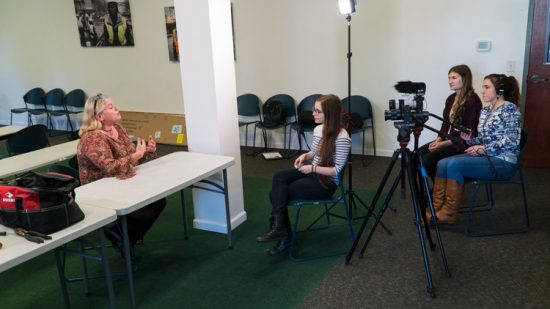
Each of the four episodes focuses on new topics in different cities. The second episode was filmed in Portland, and investigates gender, specifically in the construction industry. Women comprise a mere 3% of the national construction trades workforce, but in Oregon, nearly 7% of apprentices in the skilled trades are women.
Oregon Tradeswomen’s Executive Director, Kelly Kupcak, and Director of Training, Amy James Neel, had the opportunity to speak with MediaLab about this disparity and what Oregon Tradeswomen is doing to bridge the gap.
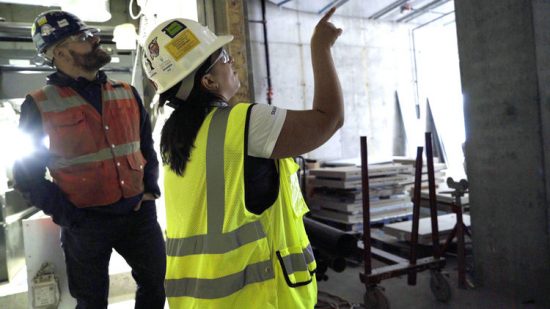
We are humbled by the opportunity to share with the world the work Oregon Tradeswomen does. We applaud MediaLab for their efforts to open a discussion recognizing the experiences of people in marginalized communities and what can be done to make a difference.
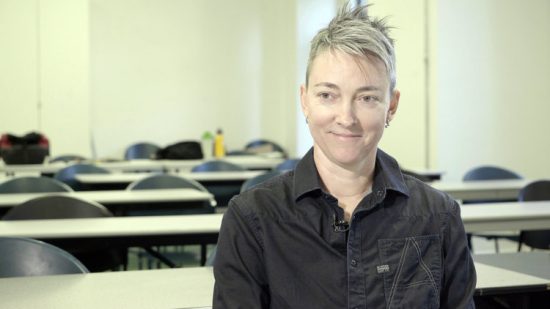
The series premier of “A World of Difference” took place on Saturday, February 17, 2018 at the Seattle Public Library. You can find the episodes available for rent or purchase on Vimeo.
Senator Ron Wyden Talks Infrastructure at Town Hall
Oregon Senator Ron Wyden held a press conference on Thursday, February 1, 2018, about the dire need for federal funding to fix roads and bridges not only in Oregon, but across the United States.
The press conference took place at the Marquam Bridge, one of the bridges in Multnomah County in need of structural reinforcement in the case of a seismic event. Nearly all of Oregon’s major construction unions were represented at the event, as well as Oregon Tradeswomen’s Executive Director, Kelly Kupcak.
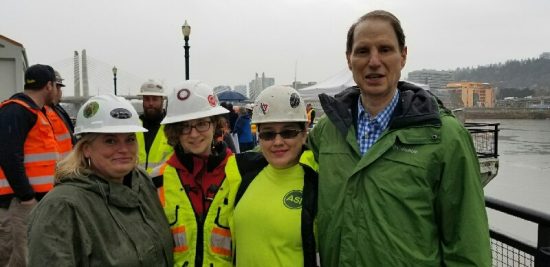
Pictured from Left: Kelly Kupcak (Oregon Tradeswomen), Nicole Rappaport (Local 701), AJ Banuelos (Local 737), and U.S. Senator Ron Wyden
Senator Wyden addressed President Trump’s purported intention to raise $1.5 trillion to fix our nation’s failing infrastructure. Senator Wyden said, “The way you improve bridges and roads and do all the great work these people do is with real federal dollars… We still haven’t heard from the president and the Republicans how that’s going to happen.”
Sources from the Trump administration claim that only $200 billion would come from the federal government, putting the pressure on state and local governments to raise the rest of the money. Since 2003, the Oregon Department of Transportation (ODOT) has been making major efforts to fix Oregon’s bridges and even with the $5.2 billion plan approved by state legislature in 2017 to invest in our infrastructure, federal aid is needed to truly strengthen our roads and bridges to the extent needed.
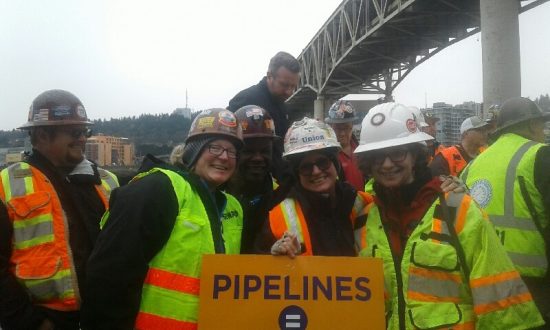
In 2009, Senator Wyden authored the bi-partisan Build America bonds program that successfully generated $181 billion for public works projects and created 3,500 jobs in Oregon. Now, the Senator is calling on the current administration to help fund the rebuilding of the nation’s infrastructure by endorsing a plan to use some of the $2.6 trillion coming back into America’s economy as a result of the tax cuts implemented in December 2017.
Investing in infrastructure not only improves our local and national economy by creating jobs and reliable mobility for people and businesses, but it is also a critical issue of public safety. We applaud Senator Wyden for his efforts in making sure that funding to maintain a strong infrastructure for our country is a priority for our government.
2017 Construction Equity Day
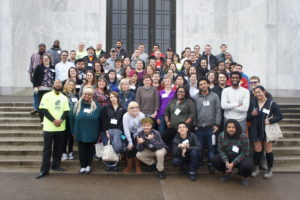
On February 23rd, staff and students from Oregon Tradeswomen, Inc., Portland Youth Builders, and Constructing Hope bused down to the State Capitol in Salem, OR for Construction Equity Day! This group of 80 people spent their day educating State Legislators about the importance of pre-apprenticeship programs and advocating for their continued funding. Measure 98, which promotes Career and Technical Education (CTE) and SB 292/HB 2167, which focuses on reducing bullying and harassment in the workplace, were also a major focus of advocacy efforts. Students had more than 20 scheduled meetings with legislators and navigated them with confidence; sharing their personal stories about how the trades industry has changed their lives. Some highlights for students included listening to a speech from Tim Frew, the Executive Secretary of the Oregon Building and Construction Trades Council, and meeting with Tina Kotek, Speaker of the House as well as Democratic Representative, Tawna Sanchez.
We at OTI are so proud of our Trades and Apprenticeship Career Class (TACC) students. They, along with the other students in attendance, led with power and demonstrated how to use their “construction voices” to advocate for the necessity of creating a more diverse workforce. The success of the day is truly owed to them! Special thanks to Alice Bartlett from the League of Women Voters for speaking with students about the importance of lobbying and legislation and to the Multnomah County Bar Foundation for providing the funding to make this event possible.
We would also like to thank our four legislative meeting leaders who just graduated from the most recent Trades and Apprenticeship Career Class. These students spent time preparing for this day and led their peers in developing their stories and meeting with Legislators – Nora Aguilar, Freedom Moreno, Nora Sackett, and Sumer Smith.
Community Event: An Oregon Agenda for Racial, Gender, and Economic Justice

OTI staff members Emma Brennan and Brynn Hall attended the Oregon Agenda for Racial, Gender, and Economic Justice on December 1st. The event was held at the historic First Baptist Church on Vancouver Avenue and was put on by Oregon’s Fair Shot for All Coalition and the Oregon Health Equity Alliance (OHEA) with the goal of reaffirming our community’s commitment to racial and economic justice.
Amidst the political turmoil our country is facing during the post-election season, Kathy Wai of the Asian Pacific American Network of Oregon urged audience members to continue the fight for equality stating that “our resistance and solidarity is crucial” during this time. Further powerful speeches were heard from Amira Streeter of the Urban League of Portland, Nancy Haque of Basic Rights Oregon, and Tom Chamberlain of the Oregon AFL-CIO.
A bold 2017 legislative agenda was announced with the hopes that Oregon can continue to lead the country in it’s fight for racial, gender, and economic justice for all Oregonians.
- Cover all Kids promises insurance coverage for all Oregon children so they can thrive in school and start on a pathway to success in their lives.
- End Profiling aims change the culture of policing in Oregon to make neighborhoods safer and communities stronger by funding and creating the system needed to identify patterns of profiling and enacting accountability mechanisms to address profiling when it occurs.
- Paid Family Medical Leave will ensure that Oregonians can welcome a new child or take care of their own or their family member’s serious health needs without losing the income their family relies on.
- Reproductive Health Equity will ensure that preventative reproductive health coverage is available at zero out of pocket cost for the people who have been categorically excluded from health programs due to citizenship status and/or gender expression.
- Stable Homes for Oregon Families will prevent no-cause evictions and repeal the ban on rent stabilization in order to help working families maintain housing stability and curb homelessness.
It was inspiring to see the community come together to fight for racial, gender, and economic equity and it is our belief that this legislative agenda will positively affect tradeswomen and their families. Visit the Fair Shot for All website for more information about how to get involved to make Oregon a state where everyone has opportunity.
Rock against the TPP
 Fight for the Future, Firebrand Records, Rage Against the Machine guitarist Tom Morello, and a large coalition of labor, environmental, and social justice groups are organizing Rock Against the TPP, a nationwide series of large-scale educational concert events to raise awareness about the dangers of this agreement.
Fight for the Future, Firebrand Records, Rage Against the Machine guitarist Tom Morello, and a large coalition of labor, environmental, and social justice groups are organizing Rock Against the TPP, a nationwide series of large-scale educational concert events to raise awareness about the dangers of this agreement.
The tour will be in Portland, OR on August 20th at Director Park with a concert featuring popular punk band Anti-Flag, Golden Globe nominated actress Evangeline Lilly, bilingual dance-rock band Downtown Boys, Shihasin of the Navajo Nation, Afro-Latin reggae vocalist Taina Asili, and more. There will also be a teach-in before the concert and Evangeline Lilly will host a training on How to Fight the TPP on Sunday, August 21st at 1pm at the First Unitarian Church. All events are free, all ages, and wheelchair accessible.
As you likely know, the TPP is a massive trade deal (like NAFTA) that was negotiated in complete secrecy with hundreds of lobbyists from large corporations setting the agenda. It poses a serious threat to our basic democratic process as well as jobs, the environment, internet freedom, human rights, food safety, and more.
Visit Rock Against the TPP for more information.
OTI Endorses Ballot Measure 98
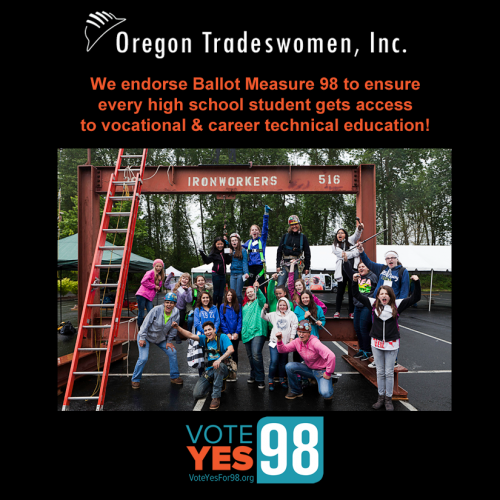
Every year, at least 10,000 Oregon high school students don’t graduate. Many of those who drop out simply lose interest and disengage. After years of repeated budget cuts to our high schools, many critical learning opportunities have been taken away from Oregon students. Ballot Measure 98 would change that by restoring and expanding vocational and career technical education (CTE), college preparation courses, and Advanced Placement classes in all high schools.
This is an important step for Oregon businesses, too, as many employers in construction, manufacturing, engineering, and computer coding are currently having difficulty local skilled workers, and the situation is only going to intensify as the skilled workforce in these industries approach retirement.
Learn more at VoteYesFor98.org
Narrowing the Wage Gap

New Website and Report Explores How Improving Women’s Access to Middle-Skill Jobs Can Narrow the Wage Gap while Filling a Skills Gap in Growing Sectors
Studies show that half of the gender wage gap is due to women working in different occupations and sectors than men. Improving women’s access to good middle-skill jobs can help close the wage gap and improve women’s economic security.
The new Pathways to Equity Initiative from the Institute for Women’s Policy Research (IWPR) shows careers that can improve women’s economic standing and meet employers’ demands for skilled workers. IWPR launched a new interactive website, womenandgoodjobs.org, which helps users identify pools of skilled women workers who could be tapped to fill shortages, ensuring that the economy benefits from the talent of its whole workforce. Read the Initiative’s research findings and explore the site at womenandgoodjobs.org.
Harassment in the Workplace
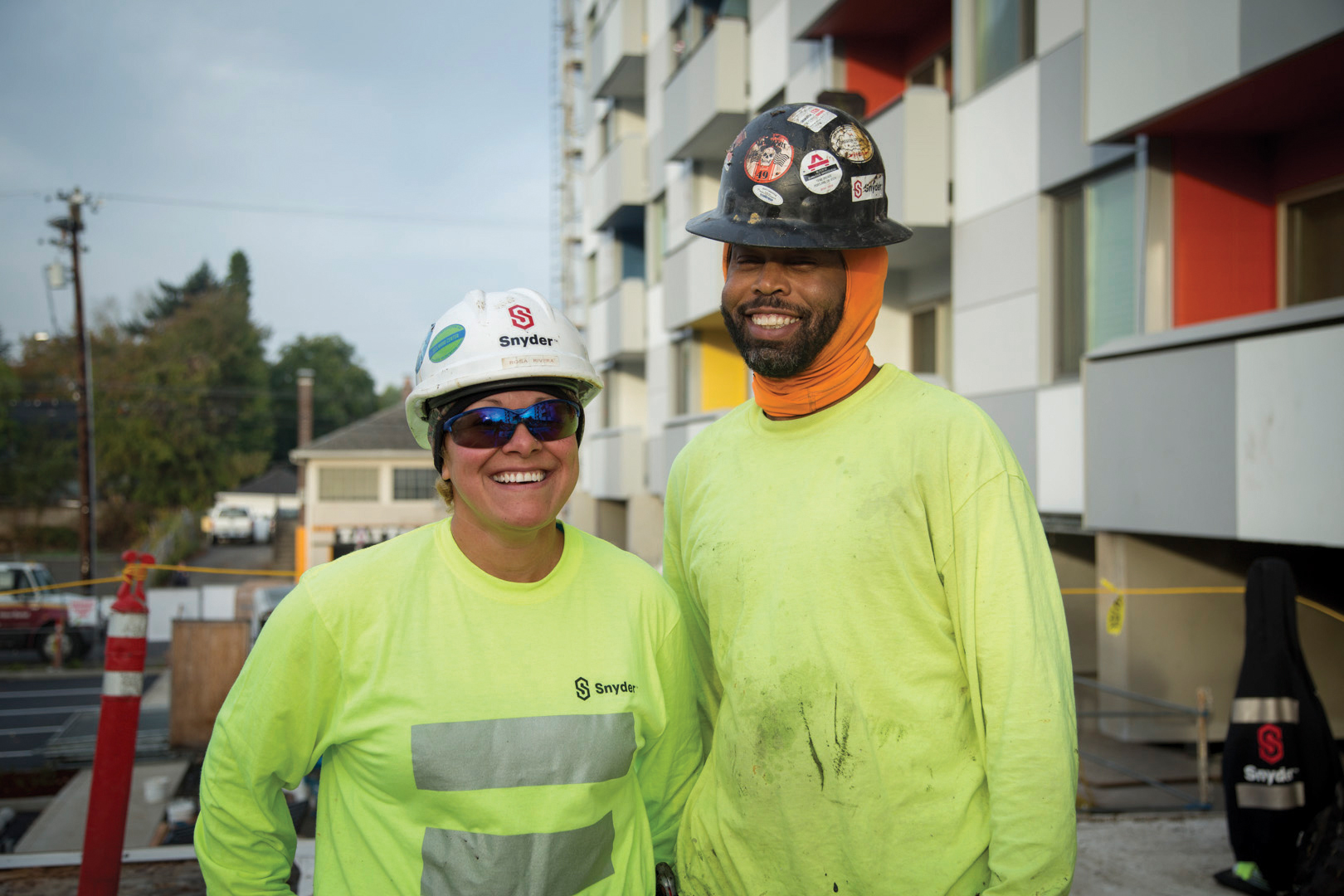
In June, the Equal Employment Opportunity Commission (EEOC) released the 2016 EEOC Harassment in the Workplace Report. OTI was pleasantly surprised to see that the report took a much broader and more comprehensive view of this issue rather than sticking to a strict legal definition.
The report acknowledges that the vast majority of workers who experience harassment in the workplace are unlikely to report the behaviors. Given this information, the EEOC is recommending prevention efforts to address workplace harassment as a remedy instead of simply focusing on the report process.
There is a section in the report that recommends the use of Bystander Intervention Training as an effective prevention model, with the caveat that more research needs to be conducted to determine the effectiveness of such models. Interestingly, OTI has been working on exactly that approach! For the last two years, OTI has been working with Green Dot (mentioned on page 57 of the report) to get funding for a pilot project here in Oregon. We are really excited that the first training for the Respectful Workplaces project will take place at the end of August!
If you are interested in this topic, but only have a few minutes, please read the summary (pages 66 – 71)! If you have more time, we recommend reading the entire report.